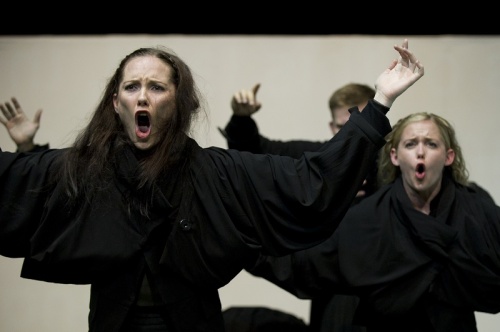MASS
29/08/2013 - 01/09/2013
Production Details
Mass is an explosive dance production that tests the mettle of personal relationships when communities are besieged with intense experiences. Created in 2011 by Dancenorth Artistic Director, Raewyn Hill.
Mass explores the idea of how communities gather, consolidate and dissipate in extraordinary circumstances. This explosive production pushes the company dancers to their physical limits as they perform within a 3-walled gallery space, with the only entrance and exit being over the walls.
Profound yet playful, with dancers scaling walls, the performance looks at multiple meanings of mass and showcases the extraordinary talents of the dancers.
Mass features the work of two acclaimed Spanish talents, with a powerful soundtrack from composer Mika Luna, vocal from Jocelyn West and digital imagery by Mariona Omedes (2011 winner of the Spanish National Award for Culture).
Dancers driven along by events
Review by Virginia Kennard 30th Aug 2013
As we wait for the performance to begin, we see a white walled space surrounding a carpet of astroturf , and there’s an eerie green glow, it feels a bit like a 1980s computer game. The walls are widest at the front of the stage and narrower towards the back of the stage, giving us a feeling of being closed in, with little avenue for escape. The text of Australian Prime Minister Kevin Rudd’s Apology to Australia’s Stolen Generation, is reverse-projected onto the walls like a wallpaper pattern.
Hill has “intentionally created a physically challenging performance in order to emulate the relentless nature of natural disasters…” making at the same time “a study of community, community that forms and dissipates.” The work’s five performers repeatedly form groups which dissolve, come together again, provide support, spread out in space, lift others, fall, drop to the ground, abandon situations, put pressure on one another.
There is a high level of energetic power within the dancing, a sense of the dancers being driven along by events and unable to prevent repeated falling to the ground, sprawling till being picked up, lurching and lunging and huddling against the walls for support. We see the dancers desparate to escape their situations — climbing the walls, leaping at the walls, being lifted over the walls, often in desperation, but also with a sense of inevitability. Women’s bodies are repeatedly depicted as being unable to provide the strength to climb, presented as rag-doll like objects which have to be lifted over the walls by others. We also see women panicking while men dance staunchly on, and much of the lifting is done by the men. These interactions undercut the idea of the community rallying together – we are shown men rallying, and women needing help, despite the evident athletic prowess, strength and stamina of all the dancers, regardless of gender.
Tapping fingers against the sternum is a repeated motif, a simple but telling gesture which reveals panic, anxiety, feeling the heart beating, monitoring the nervous system, questioning the body – am I still here? All these things. This is a rich gesture, representing the notion of creation within destruction, of hope within despair.
The imagery that remains with me has much to do with The Crucifixion: bodies hanging from walls for extended periods, splayed against white walls, somehow in suspension while traversing the surfaces against which they hang. This gives a real sense of the enduring body, damaged, in pain, especially at the times when the performers are facing towards the wall so we cannot see their faces. These are powerful motifs, chilling at times, though perhaps use of isolated, single rather than massed bodies at times could have been even more effective in building tension.
Monk-like robes bring further religious connections, adding implications to the title, MASS, to do with the uplifting of spirit through communion rather than through other community activity.
Overall, MASS is an tightly structured work, with moody, well crafted sound composition (Mika Luna with vocals by Jocelyn West), visual imagery (Mariona Omedes) and design. Well-developed motifs, and polished precision from the performers help to communicate a narrative about despair and struggle.
Copyright © in the review belongs to the reviewer





Comments